The Featured Creatures collection provides in-depth profiles of insects, nematodes, arachnids and other organisms relevant to Florida. These profiles are intended for the use of interested laypersons with some knowledge of biology as well as academic audiences.
Introduction
Hypothenemus eruditus species and from all subtropical and tropical regions (Wood 1982). This species is the type species of the bark beetle genus Hypothenemus (Coleoptera: Curculionidae: Scolytinae), which belongs to the tribe Cryphalini, the pygmy borers. With over 180 described species, Hypothenemus is one of the most species-rich genera among bark beetles. In addition, it appears to be the most common scolytine in the world (Wood 2007). In Florida, Hypothenemus are probably the most common bark beetles (Johnson et al. 2016). They are ubiquitous in forests and by far the most common bark beetles in urban and suburban areas, but they are virtually unknown to the public due to their minute size (only up to 1.3 mm). Hypothenemus eruditus is the most common cryphaline species in Florida. It is highly attracted to ethanol and it often hovers above alcoholic drinks.
Despite its prevalence, this species causes no apparent damage to plants. Most economic impacts caused by other Hypothenemus species are attributed to beetles that bore into seeds or fruits, e.g. the coffee berry borer, Hypothenemus hampei (Hulcr 2013), and the tropical nut borer, Hypothenemus obscurus.
In addition to being recorded from diverse plant tissues, e.g. leaf petioles or twigs, Hypothenemus eruditus has also been recovered from many unexpected locations, e.g. galleries of other beetles (Deyrup 1987), fungal fruiting bodies (Browne 1961), manufactured objects such as drawing boards (Browne 1961), and book bindings, from which the name (eruditus, i.e. erudite) was derived (Westwood 1836).
Taxonomy
The genus Hypothenemus was established based on the type species, Hypothenemus eruditus Westwood (Westwood 1836), and the genus name was given in reference to the downward facing mouthparts ("Hypo" means under, "thenemus" is an unusual variant of a Greek word for "mouth", Westwood 1836). The taxonomic status of Hypothenemus eruditus is extraordinarily complicated, as it includes over 70 taxonomic synonyms. The small body size (1–1.3 mm for female and 0.7 mm for male), and the subtle but extensive within-species morphological diversity may be the explanation for its unclear taxonomic placement.
The large within-species variation of Hypothenemus eruditus is also reflected in molecular markers. Beetles of this species collected at a single locality in Central America had genetic diversity equal to generic-level diversity found in other insects (Kambestad 2011). These results suggest that Hypothenemus eruditus is a complex of many cryptic species. Many of the dozens of synonyms may in fact be different species. Further comparison between morphological and molecular data is needed to resolve the taxonomy of this species.
Distribution
Hypothenemus eruditus is present in all tropical and subtropical regions of the world and is also known to extend to many temperate regions. It has been recorded across the Americas from Argentina to Michigan (Figure 1). The most comprehensive records can be accessed on the www.barkbeetles.info online database (Atkinson 2016).
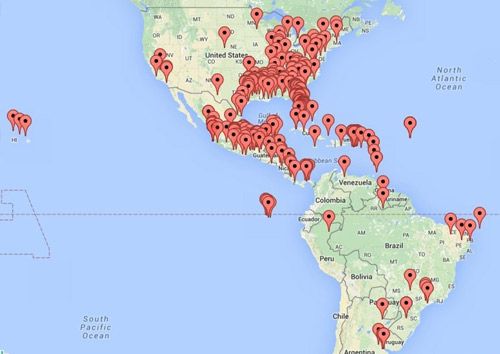
Credit: Atkinson (2016)
Description
Adults
The adult females are 1.0–1.3 mm long, and 2.4 times as long as wide. Coloration is variable: dark brown or black. Some individuals are distinctly bicolored with a light brown to orange pronotum (the upper or dorsal surface of the first thoracic segment) and black to brown elytra (the two external and hardened forewings of adult Coleoptera). The pronotum is widest at its base, 0.9 times as long as wide, broadly rounded frontally, highest at middle. The frontal slope of the pronotum is asperate: covered with distinct flat projections bent backwards. The anterior margin of the pronotum bears six such projections (asperities) and the medium pair is usually narrowly separated. The elytra are 1.7 times as long as wide. Elytral striae (longitudinally arranged lines on the elytron) consist of small punctures. The interstriae (spaces between the striae) are twice as wide as the striae, smooth, somewhat glossy, each with a straight row of minute punctures. An important character for this genus is the arrangement of setae on the elytra: they resemble flattened erect scales arranged in simple rows. The elytral end (the "declivity") is convex and steep.
The adult males are 0.7 mm long. Male eyes are only half as large as female eyes, and many other morphological features are poorly formed. Males do not fly; they only have vestiges of wings and their elytra are fused and therefore functionless. The males are less common than females in a single gallery, typically only a single male is produced per family.
Eggs
The eggs are oval in shape, and white in color. They are approximately 0.3–0.5 mm long and 0.2–0.25 mm wide. Eggs are laid loosely in the larger central chamber of gallery system (tunnels engraved by beetles).
Larvae
The larvae are white, C-shaped, and legless. They are approximately 0.6–1.2mm long.
Biology
A new gallery (the nest of a bark beetle) is initiated with one single entrance hole by an adult female, usually located at leaf nodes or stems of a dead twig (Figure 2). Each initiating female has typically been fertilized by her brother in her natal gallery, so she does not need to attract a mate. If a branch is occupied by multiple families and galleries are intermingled, females can also mate with non-sibling males (Browne 1961).
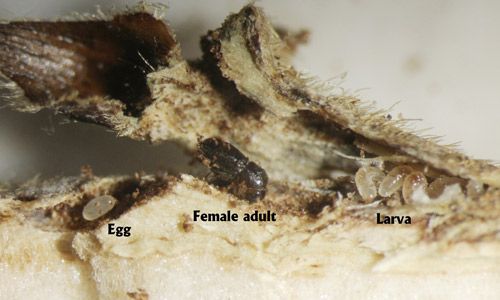
Credit: Yin-Tse Huang, UF/IFAS
During gallery excavation, the female pushes frass and debris out of the entrance hole. While excavating, she also lays eggs loosely in the gallery system, typically in the larger central chamber. The eggs are very large in comparison to the size of the female. After hatching, the larvae extend the irregular parental tunnel as they feed (Wood 2007).
In the field, development from egg to adult takes approximately 28 days (Browne 1961). There is a skewed sex ratio favoring females. Sex determination in Hypothenemus is an example of pseudo-arrhenotoky, where the male develops from a fertilized egg but the father's genome in most cells of his body is never "unfolded" and remains unused, resulting in an individual that only uses a single copy of its mother's genome ("functional haploidy") (Borsa and Kjellberg 1996).
Female adults may remain in the galleries after mating with males, either for maturation feeding or to wait for proper environmental conditions to disperse. Dispersing females may come out via the original entrance hole or through new exit holes.
Diagnosis
Hypothenemus eruditus can frequently be confused with two commonly encountered Hypothenemus species in tropical and subtropical regions (e.g. Florida) such as Hypothenemus seriatus and Hypothenemus birmanus. Among adult females of all three species, Hypothenemus birmanus is the largest (1.5–2.2 mm), followed by Hypothenemus seriatus (1.3–1.5 mm), then Hypothenemus eruditus (1.0–1.3 mm) (Figure 3). Hypothenemus birmanus can be easily distinguished by its distinct pronotal asperities: the edge of the pronotum has only four teeth, the median pair is larger than the outer pair. Hypothenemus seriatus and Hypothenemus eruditus usually possess six marginal asperities of similar size and spacing (Figure 4). Hypothenemus seriatus has a groove on its frons (the upper anterior part of the head capsule); the groove is absent or not obvious in Hypothenemus birmanus and Hypothenemus eruditus (Wood 2007) (Figure 5). However, the presence of the groove is variable, even for individuals from the same gallery (A. J. Johnson, unpublished). The interstrial bristles (bristles between the striations) of Hypothenemus birmanus are denser on the abdominal end of elytra than on the top of elytra, while relatively evenly distributed in Hypothenemus seriatus and Hypothenemus eruditus. The end of elytra is less steep in Hypothenemus seriatus and has distinct strial rows. The elytral declivity in Hypothenemus eruditus and Hypothenemus birmanus is relatively steep, and the strial or interstrial rows are not arrayed as neatly as in Hypothenemus seriatus (Figure 6).

Credit: Yin-Tse Huang, UF/IFAS
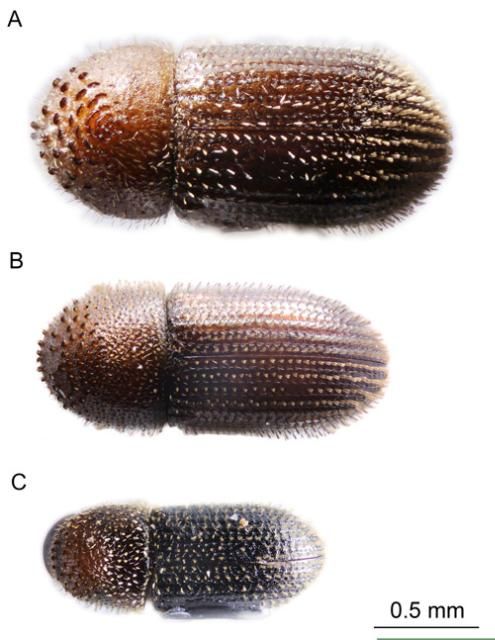
Credit: Yin-Tse Huang, UF/IFAS
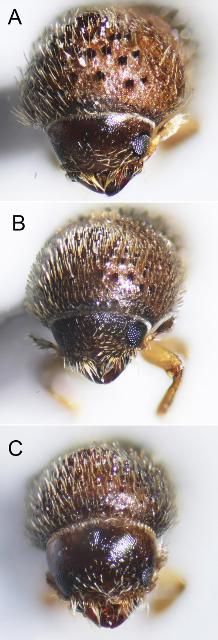
Credit: Yin-Tse Huang, UF/IFAS
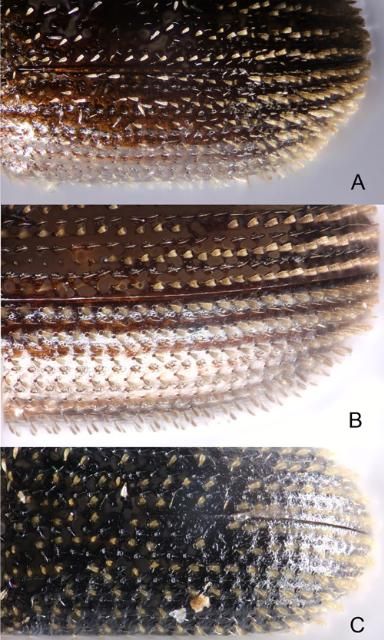
Credit: Yin-Tse Huang, UF/IFAS
Hosts
Hypothenemus eruditus is often described as a "super generalist" since it can feed on a wide variety of phylogenetically diverse plants. It can also use various plant organs, from leaf petioles and twigs to seeds and fruits. The most comprehensive host list is available in Atkinson (2016).
Damage and Management
Hypothenemus eruditus has been reported inside coffee berries, but it does not consume the seeds and does not reproduce in them (Garcia Martell 1980). The damage caused by this species is quite limited. Actually, the term false coffee berry borer has been used to describe Hypothenemus species that appear in coffee berries without causing significant damage to the host (Garcia Martell 1980).
Despite its abundance in Florida and around the world, Hypothenemus eruditus does not cause any significant economic damage and requires no management.
Selected References
Atkinson TH. 2016. Bark and Ambrosia Beetles. http://barkbeetles.info (September 2019)
Borsa P, Kjellberg F. 1996. "Experimental evidence for pseudo-arrhenotoky in Hypothenemus hampei (Coleoptera: Scolytidae)." Heredity 76: 130–135.
Browne FG. 1961. "The biology of Malayan Scolytidae and Platypodidae." Malayan Forest Records 22: 1–255.
Deyrup M. 1987. "Trischidias exigua Wood, new to the United States, with notes on the biology of the genus (Coleoptera: Scolytidae)." The Coleopterists Bulletin 41: 339–343.
García Martell C. 1980. Falsas brocas del género Hypothenemus detectadas en frutos del cafeto en México. III Simposio Latinoamericano sobre Caficultura, Tegucigalpa, Honduras. 188–195.
Hulcr J. 2013. Why is your cup of coffee so expensive? Because of atiny bark beetle! FOR314. Gainesville: University of Florida Institute of Food and Agricultural Sciences. (September 2019)
Johnson AJ, Kendra PE, Skelton J, Hulcr J. 2016. "Species diversity, phenology, and temporal flight patterns of Hypothenemus pygmy borers (Coleoptera: Curculionidae: Scolytinae) in South Florida." Environmental Entomology 45: 627–632.
Kambestad M. 2011. Coexistence of habitat generalists in neotropical petiole-breeding bark beetles: Molecular evidence reveals cryptic diversity, but no niche segregation. University of Bergen.
Vega FE, Infante F, Johnson AJ. 2015. The genus Hypothenemus, with emphasis on H. hampei, the coffee berry borer. pp. 427–494. In Bark Beetles: Biology and Ecology of Native and Invasive Species. Vega F and Hofstetter R (eds.). San Diego, CA: Academic Press.
Westwood JO. 1836. "Description of a minute coleopterous insect, forming the type of a new subgenus allied to Tomicus, with some observations upon the affinities of the Xylophaga." Transactions of the Royal Entomological Society of London 1: 34–36.
Wood SL. 1982. "The bark and ambrosia beetles of North and Central America (Coleoptera, Scolytidae), a taxonomic monograph." Great Basin Naturalist Memoirs 1356 pp.
Wood SL. 2007. Bark and ambrosia beetles of South America (Coleoptera, Scolytidae). Monte L. Bean Life Science Museum, Brigham Young University, Provo, Utah 900 pp.